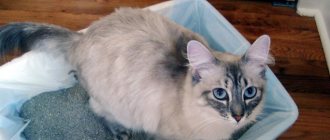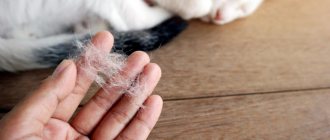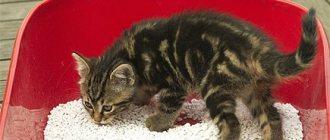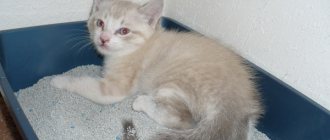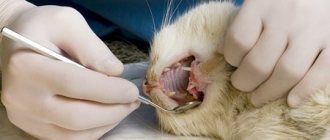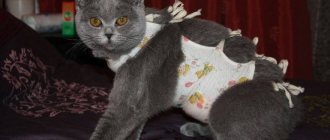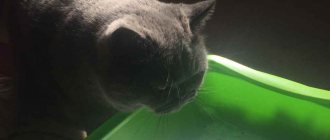10215Administration
There are certain standards regarding how many times a day a cat should pee. They depend on a number of factors, including age, body weight, type of feeding, gender and lifestyle of the pets. It is generally accepted that deviations from these norms, up or down, are a signal of problems in the body. But this is a relative statement, since it is impossible to say with milliliter precision how much urine an animal’s body should produce, based on the many nuances associated with this issue. Here we can only talk about average indicators, provided that the cat is healthy.
Frequency of visits to the litter box of an adult cat
How many times a day do cats pee?
Small kittens are much more likely to relieve themselves because they still have a small bladder. A middle-aged to mature cat may pee a different number of times per day, depending on how much liquid they have drunk. On average, the number of daily urinations in a pet is about 5 times. An older cat goes to the toilet three times a day. At the same time, owners should pay attention to whether the pet experiences discomfort or pain when urinating. In the summer, cats can pee 2 times more often, since at this time the pet’s daily fluid intake increases.
Large number of trips
The process of bowel movement in a pet depends on its age. The older the cat, the less often he has bowel movements per day. It is important to understand that the frequency of stool depends on what pets eat. If a cat eats a lot of food with a high fiber content, then it poops a lot a day, sometimes three or more. This is normal, but the owner must pay attention to the behavior of the animal and the nature of the feces, which should not contain blood impurities. A healthy cat with a balanced diet should walk twice a day, and it is not a deviation if the pet has bowel movements once every 2 days and feels well. If the stool is hard and occurs only once a week, then the cat is constipated and should consult a veterinarian.
How do newborn kittens go to the toilet?
Some people will find this question strange.
Can kittens not poop? But where then do the products of their vital activity go? In fact, kittens have been peeing and pooping since birth, but owners may not even notice it because the mother cat comes to the rescue. She simply licks the feces from her babies. During the bathing process, the cat involuntarily massages their tummies, which improves blood circulation and digestion.
The stool of animals during the first month of their life is homogeneous, similar to condensed milk. Therefore, it can be quite difficult for owners to determine how often kittens poop during this period. But this does not mean that they do not defecate at all.
Some novice cat breeders are of the opinion that a newborn kitten does not walk at all, not only in a big way, but also in a small way. However, this is an erroneous judgment. The fact is that during this period the mother cat carefully looks after him. It is she who massages the babies' anus and bladder with her rough tongue, while simultaneously licking everything that comes out of the anus.
How often do small individuals visit the tray?
In the first month of a kitten’s life, its mother takes care of it and cleans it, so there may be no traces of bowel movements.
Up to 6 months, a kitten goes to the toilet much more often than adults. This is due to the fact that his internal organs of the urinary system are smaller, so they sometimes need to pee every hour or two. Many owners think that a newborn kitten is forced to constantly endure and not defecate because there is no contamination, but this is not the case. During the first month, the female cares for the offspring and regularly licks the cubs, so it is difficult for owners to notice traces of feces or urine. Kittens begin to poop and pee fully at 2 months of age. In kittens, the daily number of urinations normally ranges from 6 to 10, and they empty their intestines up to 3 times a day. At this time, owners are recommended to gradually accustom their pets to the tray. When a cat wants to pee, some changes in behavior occur, namely:
- The pet often scratches its paw on the floor.
- The animal, before going to the toilet, sniffs objects located nearby.
- The cat stomps around for a long time and sits down.
Causes of constipation
Constipation in cats develops somewhat less frequently than diarrhea.
The following reasons can provoke this phenomenon:
- incorrect feeding system with excess protein;
- dehydration, when stool becomes too hard and cannot pass out of the intestines;
- lack of movement leading to digestive disorders;
- intestinal obstruction (constipation is not the only symptom);
- the presence of hair in the intestines;
- severe stress (leads to constipation and diarrhea equally);
- hernias;
- tumors of a malignant or benign nature.
Giving an animal a laxative until the cause of the disorder is determined is unacceptable. The veterinarian will determine how to properly solve the problem.
Why do deviations occur?
A cat may not go to the toilet for major or minor needs for 1-2 days, or even more, which may indicate health problems. The following symptoms indicate a pathological condition in your pet:
If the owner notices the animal’s restless behavior and meowing during bowel movements, this indicates a pathological process.
- lack of urine or feces when going to the litter box;
- pain when going to the toilet, accompanied by loud meowing;
- blood and other impurities in urine or feces;
- high fever, hot ears and nose;
- reluctance to eat food;
- abdominal enlargement;
- apathy;
- gagging and vomiting itself;
- weight loss.
Veterinarians note that the main reason why a cat does not go to the toilet in a big way is deviations in nutrition.
The impaired process of urine excretion is in most cases associated with urolithiasis or cystitis, accompanied by an inflammatory reaction in the bladder. Often, one-month-old kittens and older ones do not go to the toilet to poop due to early weaning from their mother. As well as British cats and other breeds of the feline family, they experience constipation for the following reasons:
- influence of stress;
- poor diet with lack of fiber;
- worm infection.
How to avoid urinary problems
It is impossible to avoid problems that are closely related to the life of a pet. Urgent intervention is required to aid recovery.
If you notice that your cat is often running to the toilet or, conversely, rarely, watch for other symptoms. If the symptoms are too pronounced, contact the clinic immediately.
Always contact your veterinarian. This is the only person who will help cure your friend.
Monitor your pet carefully. In many cases, pets tell us what is bothering them and carefully show us how bad they feel. There are also individuals who can remain silent, which will lead to irreversible consequences. Monitor your pet's litter box and do not aggravate the situation by self-medicating.
What to do and how to help the animal?
If symptoms are detected, you must contact a veterinarian who will determine the cause of the disease.
You can’t just force your pet to go to the toilet in small or large ways. To fix the problem, you need to find out its root source. If the influence of pathological factors is excluded, and additional symptoms are present, it is recommended to consult a veterinarian. The cat should go to the litter box quickly, and the emptying process should not cause discomfort. It is worth adjusting your pet's diet. If owners feed their pet exclusively with dry food, then it is necessary to ensure constant access to water. When the cat eats regular food, then include food with fiber in the daily diet.
A cat should poop at least once a day; if this does not happen and the pet behaves restlessly, this indicates constipation. There are several ways to help an animal:
- Use of oil. Give the cat 0.5 teaspoon of herbal product once a day.
- Medications. If there are problems with stool, the veterinarian will prescribe laxatives for the cat.
- Using an enema. The procedure can be performed at home or in a veterinary clinic. Manipulation is done only if constipation is caused by poor nutrition, and not by volvulus or an inflammatory reaction.
If the owner notices that the cat has stopped going to the toilet to pee or the daily amount of urine has decreased, then first find out what the problem is. Perhaps the reluctance to visit the toilet is due to unsuitable filler or its poor quality. In this case, it is enough to change the product. It is more difficult to help an animal when impaired urination is associated with a disease. The sick cat then requires special medications prescribed by the veterinarian.
Possible problems with urination and defecation in kittens
A small kitten must be properly cared for so that it can develop and grow normally. If he is separated from his mother and finds himself in the house of a new owner, then the adaptation period may be accompanied by stress. A number of negative factors can affect the weakening of an animal’s immunity. This affects the functioning of all body systems. Absence or problems with urination and bowel movements during this period are quite acceptable.
When the kitten has grown up and settled down, has become the owner of an excellent appetite, but does not go to the toilet properly, it is worth wondering if everything is okay with him.
How to deal with constipation in a kitten yourself
If your pet feels well enough, you can try to cope with your kitten’s constipation yourself with the help of:
- Oils: if the kitten does not go to the toilet for several days, you can give simple vegetable oil in an amount of no more than half a teaspoon per day. You can introduce it into the mouth using an ordinary syringe without a needle, slowly so that the kitten does not choke. Vaseline oil is also effective for constipation. It can be added at each feeding, 0.5 ml, in combination with a gentle therapeutic massage.
- Soap: you need to make a small peg of baby soap and insert it into the anus. Before administration, the soap should be moistened in warm water. It is more convenient to carry out this action while the pet is sleeping. After it, within a few hours, the kitten should successfully go to the toilet for the most part.
- Medications: You should consult your veterinarian about the appropriateness and correct use of medications.
- Enema: the enema procedure at home is carried out only in full confidence that it is harmless to the kitten. This procedure is relatively safe only if the cause of constipation is precisely inappropriate nutrition, and not intestinal obstruction or volvulus. There is a list of conditions for which an enema is strictly contraindicated: inflammatory processes in the intestines, bleeding, rectal prolapse, acute pathologies of the abdominal organs, inflammatory processes in the intestines.
Do-it-yourself enema of a kitten
To do an enema yourself, you will need a 10-milligram syringe, warm boiled water, Vaseline or oil. It is advisable to do the procedure with an assistant: one will hold the kitten, and the second will slowly insert a syringe pre-lubricated (with Vaseline or oil), deep enough so that the liquid is distributed as intended.
During the procedure, you need to slowly introduce water, gently palpating the pet's stomach to ensure that the intestines are sufficiently full. For a kitten, 50-100 ml of water is enough for the procedure.
Frequent stool
When a kitten suffers from diarrhea, this is a sign of a serious malnutrition problem. This situation will require urgent measures and treatment. The entire course of therapy must be carried out under the supervision of a veterinarian.
The most common reason is a change in diet. If the kitten does not receive its usual food, diarrhea occurs. It is necessary to return to your previous diet as quickly as possible.
Changing a kitten’s diet should not be abrupt; it is carried out according to a certain scheme.
There are other reasons for frequent bowel movements in kittens:
- Binge eating. Food that comes in large volumes cannot be digested normally and enters the intestines in liquid form. It is important to control kittens' portions according to their age.
- The food is not suitable or bad. You cannot feed your kitten pickled, fried, salted, or expired foods. This food is not suitable not only for kittens, but also for adult cats. It is not absorbed and causes diarrhea. Also, cats are not given food from the owner’s table (primarily because it contains salt, sugar or spices); food for animals must be prepared separately.
- Allergies or intolerances. Often kittens cannot digest or assimilate fatty fish, beef, and corn. It happens that some elements cause an allergic reaction.
- Poisoning. This phenomenon can be caused not only by food, but also by various substances. A kitten, due to its curiosity, can fit anywhere. Therefore, household chemicals and other chemical elements should be stored out of reach. If the baby is poisoned, then vomiting and lethargy will be added to the diarrhea. Only a specialist can help here.
- Parasites. The first and obvious sign of a kitten being infected with worms is diarrhea with mucus. Only medications can help here. If the case is advanced, then the help of a veterinarian is needed.
- Diseases. The cause of diarrhea can be infectious lesions in the body of a small pet.
Determining the causes of diarrhea
To get rid of the problem of frequent bowel movements, you need to find out its cause. To do this, you need to conduct a stool analysis. Factors of color, consistency, and impurities play a role here:
- Stool with a yellow tint will indicate that the kitten has been poisoned by some kind of food.
- If the feces have an admixture of blood or mucus, then this speaks in favor of helminthic infestation.
- Brown diarrhea indicates an allergic reaction.
- If the stool has a green tint and a persistent unpleasant odor, then the kitten has been poisoned by chemicals.
How to help a kitten with diarrhea
If loose stools have become a one-time occurrence, and the kitten feels normal, that is, he is alert and does not have a fever, then you can simply give the baby plenty of water and put him on a diet. The food restriction should continue for several days until everything returns to normal. In addition, you can give your pet a quarter of a tablet of activated carbon. If diarrhea is prolonged, accompanied by a deterioration in general condition, then an urgent visit to a doctor is necessary. He will be able to diagnose the cause and prescribe treatment.
Urination in kittens: normal and abnormalities
In order to determine how often a kitten pees, you need to track how often it drinks water. The amount of fluid you drink should correspond to the amount of urine. An older kitten will empty its bladder up to 5 times a day. The process does not cause discomfort to the baby. Urine should be clean and transparent without any admixtures of blood or mucus.
Acute urinary retention
Acute urinary retention is a condition in which the animal does not urinate for 24 hours. It is dangerous and life-threatening for the pet. As a result of excessive overfilling, the bladder may rupture, causing urine to leak into the abdominal cavity. Intoxication of the body occurs, and then the death of the pet occurs.
Acute urinary retention is more often detected in cats, but in cats it is classified as an infrequent pathology.
The cause of this dangerous pathology is most often stones that block the outflow of urine. However, there are a number of other factors that experts highlight:
- Obstruction (blocking) of the urethra with a blood clot or mucus, pus. Often occurs in cats that have had a trauma to the penis or a disease associated with an infectious carrier that has affected the specified organ. This can also be caused by a bladder infection.
- Kidney dysfunction. The animal's body becomes unable to excrete even a minimal amount of urine. This may be due to organ perforation or tumor.
- Spinal injury or infection that has penetrated the spinal cord. In this case, the innervation of the urinary and urinary organs may be disrupted, which is why the animal stops urinating.
Acute urinary retention requires immediate medical attention. There they can do:
- Catheterization. A special catheter is inserted into the urethra, through which the bladder is emptied.
A catheter is inserted into the urethra, allowing urine to flow out
- Operation. It is performed after several catheterizations if the cause of urinary retention cannot be eliminated by conservative methods.
My cat has had her bladder catheterized several times. But the problem could not be solved in this way. The outflow of urine was hampered by the appearance of a tumor. We agreed to the operation, but, unfortunately, the cat did not survive it; she was already an elderly lady.
No urination
If a kitten pees little or does not pee at all, there may be a number of reasons for this:
- suffered stress;
- diseases of the urinary tract;
- kidney disease;
- small amount of fluid consumed;
- exhaustion.
Also, the kitten may not visit the litter box if it is dirty, he does not like the litter, etc.
Many cats are very picky about the cleanliness of the litter box and the contents in it.
If the baby does not pee for a long time, and the owner notices weakness and apathy, lack of appetite, irritability, then you should urgently contact a veterinarian to establish a diagnosis and begin timely treatment.
No matter how many cats and kittens appeared in my house, during the first 24 hours no one peed or pooped. When entering a new home, any animal experiences stress. We understand that he will feel good here, no one will offend him. The cat is not sure about this yet. Therefore, she has no time to relieve herself. She should investigate everything and calm down.
Frequent urination
If a kitten pees frequently, then most likely he has developed cystitis, a disease of the urinary organs, or urolithiasis. The baby will often run up to the tray, but the volume of urine will be catastrophically small. Sometimes there is blood in the urine.
Frequent urges can be caused by drinking too much in hot weather, as well as diabetes. Urinary incontinence is accompanied by a large amount of fluid released and no bleeding. The same signs are characteristic of marking territory.
Cystitis most often occurs in adult kittens. The reasons may be:
- drafts;
- sand in the kidneys;
- impaired metabolism;
- mineral imbalance;
- sexual infections;
- predominance of dry food, lack of liquid and proteins.
Deviations from the norm should be studied and treated in veterinary clinics
Cats of any age can get urolithiasis. Signs of the disease are:
- unsuccessful visit to the tray;
- a tiny amount of urine;
- presence of blood in the urine;
- vomiting and high fever;
- lethargy and apathy.
There are cat breeds that are genetically predisposed to this disease. Among them are Scottish Fold, Persian and Siamese breeds.
Also, frequent urination can be associated with diabetes, stress or enuresis. In any case, assistance to the pet must be qualified and timely. If there is the slightest sign of a pathological condition, you should immediately contact a veterinarian. He will prescribe a number of diagnostic measures and adequate treatment.
A kitten who pees frequently will undergo the following tests:
- blood biochemistry;
- Analysis of urine;
- X-ray;
- comparison of the amount of urine and drink;
- Ultrasound;
- hormone test;
- determination of acetone levels and acid-base balance.
These types of studies will help to identify the nature of the disease of the genitourinary system, make a diagnosis and decide on treatment.
In addition to adequate therapy, it is important to carry out a number of preventive measures for the full functioning of the genitourinary system. Regular medical examinations, proper diet, physical activity, and the optimal amount of drinking will ensure normal urination and healthy urinary tract of the kitten.
Too infrequent visits to the litter box
Rare urination is just as dangerous to a kitten's health as frequent urination. In such situations, the main cause is pathological processes, both in the genitourinary system and in the body as a whole. Almost 75% of cases of insufficient urine flow or insufficient discharge occur due to cystitis. Lack of proper treatment will invariably lead to a condition such as acute urinary retention.
Having such a diagnosis, a kitten may not walk for more than a day. This is a dangerous phenomenon that often ends in death. The bladder becomes full and bursts. Urine enters the abdominal cavity, which can lead to intoxication of the body and death of the pet.
Kittens need to be fed crushed food.
The pathology most often occurs in male kittens. For females, such a disease is not typical, although it is also sometimes detected. The main cause of the disease is stones that block the urinary tract. Experts identify other factors:
- blockage of the urethra by a blood or mucus clot. Occurs against the background of trauma to the genital organ or an infectious disease, in particular the bladder;
- abnormal kidney function. With renal dysfunction, the kitten’s body can no longer excrete urine even in minimal volumes. The cause may be a malignant tumor or perforation of the kidney;
- spinal injury or infectious disease affecting the spinal cord. The absence of a nervous connection between the genitourinary organs and the spinal cord leads to disruption of their functioning and the cessation of urination of the animal.
Urinary retention of any stage requires urgent treatment. In the clinic, a kitten may be prescribed the following procedures:
- catheterization using a special catheter that is inserted into the urethra. This will help empty your bladder;
- surgical intervention. Prescribed in case of ineffectiveness of repeated catheterization.
To prevent advanced cases of impaired urination, the owner of kittens must take preventive measures daily:
- animals must receive anti-infective vaccinations on a schedule;
- avoid hypothermia;
- provide access to an unlimited amount of fresh and clean water;
- the diet must comply with the kitten’s nutritional rules according to its age;
- an active lifestyle and outdoor games will also be beneficial.
For any pathological conditions or deviations from the norm, it is prohibited to prescribe medications yourself. Kittens must be treated by a veterinarian. He will also tell you how many times a kitten should poop and pee per day. This will keep your little pet healthy and alive.
Symptoms and prevention of urolithiasis
Having decided how many times a day a 4-month-old kitten should pee, pet owners often ignore real symptoms that indicate problems with the urinary system. Irregular urination may indicate urolithiasis, which is more common in males of any age.
Diarrhea in kittens
Another, no less unpleasant defecation disorder in kittens is diarrhea.
Before diagnosing your pet, you need to figure out how often kittens poop and whether it’s diarrhea at all. Many owners believe that if a kitten’s stool becomes liquid, then this is diarrhea. However, it is not.
Diarrhea is not only watery stool consistency, but also a frequent urge to defecate. An additional symptom may also be bloating.
The causes of diarrhea in an animal can be helminthic infestations, poor nutrition, infectious and inflammatory diseases. On a psychological level, early separation of a kitten from its mother can provoke diarrhea.
If a kitten has diarrhea, it is advisable not to feed it for about 12 hours, but to give it only water. By the way, he must drink. Not drinking water can lead to dehydration.
In this case, a sorbent such as Smecta or Enterosgel can be used as a medication.
If attacks of diarrhea no longer recur, then after 12 hours the pet can be fed. First, a little boiled rice or three-day (!) kefir is given. Fresh fermented milk products can only worsen the situation. The next day, boiled chicken meat, and so on, expanding the diet.
In any case, self-medication is not recommended for either people or animals. Therefore, if there are various disturbances in the process of relieving yourself in your little family member, you need to show him to the veterinarian.
When should you contact a veterinarian?
Pathology is indicated by weakness, lethargy and apathy, excessive appetite or refusal to eat, and weight loss. Other reasons to contact a veterinarian:
- indigestion (vomiting, diarrhea or constipation);
- increased or decreased body temperature;
- pallor of the mucous membranes;
- uncharacteristic impurities in the urine (pus, blood);
- strong unpleasant odor of urine.
Some diseases have subtle symptoms, so if the deviation in the number of urination acts persists for more than 3 days, you should show your pet to a doctor. Under no circumstances should you self-medicate; this can aggravate the situation and lead to dangerous complications.
Reviews
The cat stopped peeing, they took him to the veterinarian: they gave him injections for 3 days and then installed a catheter. He walked with him for a day and accidentally pulled it out (((((then another 3 days of injections + ultrasound (everything is fine, there is only a little sand in the urine, no stones). But the cat still did not begin to pee! They put a catheter again + castrated (they thought) , that the spasm is due to this). I spent 5 days with a catheter, yesterday they removed it. He is walking drop by drop again
